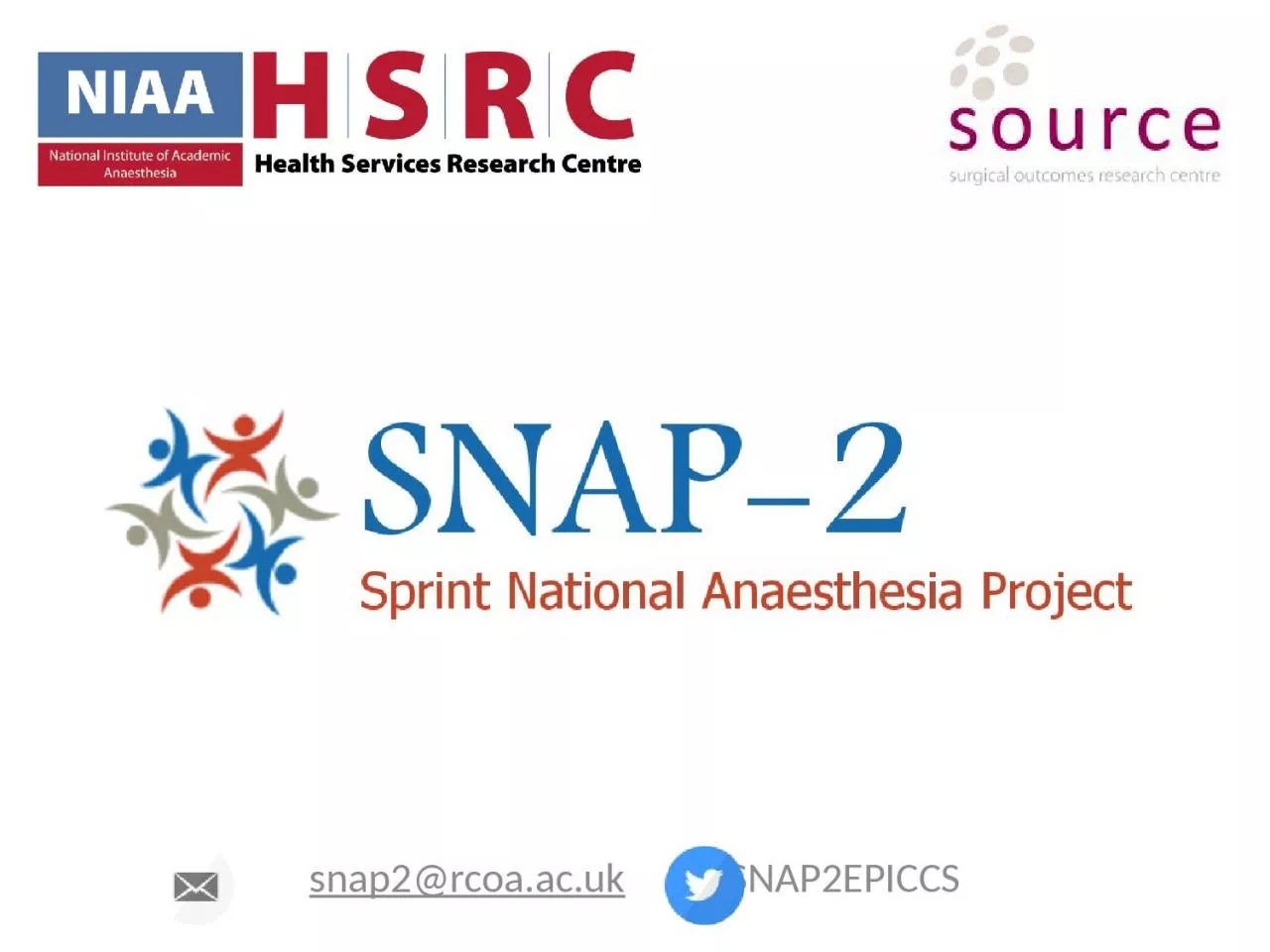

SNAP2 EPIdemiology of Critical Care provision after Surgery EPICCS The Problem 80 yo granny needs surgery Multiple comorbidities High risk Where should she go afterwards httpitelegraphcoukmultimediaarchive02712GRANNY82712464ajpg ID: 1041713
Download Presentation The PPT/PDF document "SNAP-2 snap2@rcoa.ac.uk @SNAP2EPICCS" is the property of its rightful owner. Permission is granted to download and print the materials on this web site for personal, non-commercial use only, and to display it on your personal computer provided you do not modify the materials and that you retain all copyright notices contained in the materials. By downloading content from our website, you accept the terms of this agreement.
1. SNAP-2snap2@rcoa.ac.uk @SNAP2EPICCS
2. SNAP-2: EPIdemiology of Critical Care provision after Surgery (EPICCS)
3. The Problem80+ y/o granny needs surgeryMultiple comorbiditiesHigh risk!Where should she go afterwards?http://i.telegraph.co.uk/multimedia/archive/02712/GRANNY8_2712464a.jpg
4.
5. ≥10% mortality risk Critical Care≥5% mortality risk Critical Care
6. Low Critical Care Admission Rates1999-2004: 12.5% of patients are high-risk, account for >80% of deaths. But <15% admitted to Critical Care.2011: 6.3% admitted to ICU/HDU in UK, 8% worldwide. 73% who died, did not go to Critical Care
7. 60% admitted to ICU/HDU89% of highest risk (≥10% mortality)64% of high risk (≥5%)
8. So why aren’t we admitting to ICU/HDU?A lack of capacity?Inadequate risk stratification?Equipoise over Critical Care benefits?
9. Lack of Capacity?Adhikari et al, Lancet 2010UK: 3.5 ICU beds/100,000 popGermany 24.6 beds/100,000
10. Lack of Capacity?
11. Extrapolating from the literature
12. Inadequate Risk Stratification?NELA: 44% of patients did not have risk documentedWide variation between hospitals which documented pre-op risk
13. We all know who’s high risk, right?
14. We all know who’s high risk, right?Elderly patientsEmergency patientsSome high risk procedures
15.
16. The Prevention Paradox Illustrated
17. The Prevention Paradox Illustrated
18. The Prevention Paradox Illustrated
19. Maybe we should risk stratify EVERYONE?http://www.sortsurgery.com/
20. Equipoise over benefits of Critical Care?No real RCT evidence to say going to ICU/HDU post-op is beneficialSmall survey prior to grant application asked:“Is there equipoise on post-op Critical Care admission with threshold predicted mortality >2%?Yes 65%No 24%Uncertain 11%
21. SNAP-2 AimsDescribe and analyse the epidemiology of critical care admission after inpatient surgery in the United KingdomDetermine whether elective postoperative critical care admission is an effective intervention in improving patient outcomes (morbidity, mortality and quality of recovery)Explore clinicians’ perceptions regarding perioperative risk stratification and postoperative critical care admission
22. SNAP-2 PlanProspective cohort study1 week duration in March 2017All UK inpatient surgeryEnrol all patients (non-consenting)Enrol all anaesthetists for clinicians’ perception (consent at anaesthetist level)Enrol subset of patients to complete Quality of Recovery Questionnaire
23. Statistical/Study Design ProblemsPowering for mortalityHazard reduction 0.7 to 0.9 & allocation ratio 1:1030-day Mortality 1%? 30-day Mortality rate 5%?Hazard Ratio (HR)Overall mortality rateMinimum number of events (deaths) required Minimum sample size (n) required0.701%60060,6050.751%92393,1590.801%1,533154,8390.851%2,890291,9040.901%6,876694,532Hazard Ratio (HR)Overall mortality rateMinimum number of events (deaths) required Minimum sample size (n) required0.705%60012,1210.755%92318,6320.805%1,53330,9680.855%2,89058,3810.905%6,876138,907
24. Powering for MorbidityGrocott, M. P. W. et al 2007. ‘The Postoperative Morbidity Survey Was Validated and Used to Describe Morbidity after Major Surgery’. Journal of Clinical Epidemiology 60 (9): 919–28.
25. Powering for MorbidityAssuming 46% morbidity and considering 5-20% reduction in morbidityProportion in general ward (p1)% reduction in ICUProportion in ICU (p2) Minimum sample size (n) required0.4625%0.43939,8740.46210%0.41610,0760.46220%0.3702,565
26. Ethics issuesMain patient study consent issues:Aiming for full coverage of ALL patients in the UKHigher risk patients may be unable/unwilling to consentDifficult to consent >10,000 patientsSection 251 exemption to record patient identifiable informationAvoid sampling bias
27. Ethics issuesClinician sub-study consentImplied consent from completion of questionnairesAsking clinicians to tell us risk assessment strategy, which may conflict with national guidelinesResponses used in confidence and without fear of litigationConsent for QoR sub-studyImplied consent if patients fill in the questionnaire
28. Ethics issuesDatabase will be hosted at the RCoA?Similar to the NELA data entry tool
29. Statistical Analysis PlanDescriptive statisticsLogistic regression for independent predictors of ICU/HDU referralCalibration of risk stratification toolsASA-PSpPOSSUMSORTSurgical risk scale
30. Clinical Effectiveness of Critical CareMethods:Propensity score matched analysisInstrumental variable analysisOutcomes:1°: Morbidity (7-day POMS)2°: Mortality (30-day, 90-day and 1 year), QoR, cost-analysis, LOS, etc
31. Propensity Score Matched AnalysisWell-established methodMatch patients going to Critical Care against controls by taking into account confounding variablesAttempts to create 2 comparable groups by matching as closely as possible
32. Instrumental Variable AnalysisUsed in economics, but less in medicineAttempts to reduce selection bias by linking allocation to intervention/control based on a random eventIV Replaces the coin tossBed occupancy levels
33. ConclusionSNAP-1 was a success! Published in December, PubMed processing >1500 collaborator namesSNAP-2 is coming, and will answer interesting questionsWe really need your help!
34. Thanks!
35. For More Informationhttp://www.niaa-hsrc.org.uk/SNAPssnap2@rcoa.ac.uk @SNAP2EPICCS